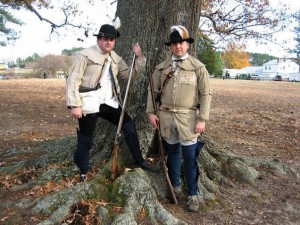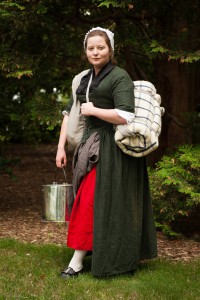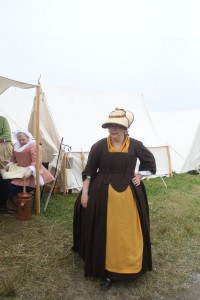Author and Authority: Creating Fashion Trends in Historical Re-enacting (Probe on Foucault’s ‘Author’)
As I begin my own process towards authorship, I have been thinking a great deal on how we create authorities out of persons who share their research. This has held exceptional resonance with me in my own work on Eighteenth Century fashion and how it is viewed by the community of re-enactors I belong to. When I began as a historical interpreter and costumer, I knew about the larger community, but did not feel a part of it. In Nova Scotia, we were a small group who did our own research and shared it with our friends, discussing and shaping ideas within a very small group (at that time, about 100 total members). With the dawn of the internet, and social media beginning with email list serves, our scope grew larger, we were now included within the larger, North American community. At that time, there were few opportunities for non-academics to publish their research. Some were able to write and publish books about and through their own local museum collections, others published articles in community newsletters. At that time, the status of the author rose to dizzying heights, they became superstars within the community and began to be noticed by the academic community. The research they published was copied extensively throughout the larger North American community with little regard to situational and cultural dynamics.
Fashion doesn’t exist in a vacuum, but neither does it exist as a wide spread phenomena. Even today, there are cultural differences in how we dress ourselves, even here in Canada. The cut of our jeans will be different in Nova Scotia than it is in Alberta, not only because our bodies are differently shaped but also because of how we wear clothing culturally. These differences relate to genetics, weather patterns, religion, and culture. In the 18th century, those cultural differences can be highly insular. What a person wore in Pennsylvania Deutch country would be different than what a Protestant Loyalist refugee would have worn on their way from New Jersey to Nova Scotia. Don’t get me wrong, fashion existed, and was not as stagnant as would first appear, but there are cultural, weather, situational, and religious differences at play. A person interpreting a figure from Nova Scotian history cannot just copy an outfit from ‘Fitting and Proper’ (Burnston, 2000) and be entirely correct.
Since the publication of this book, Sharon Burnston has become an authority on 18th century clothing. She has been given star status within the community. Others who achieved such status through early publication were not as considerate in their research though, and that research has proven to not be as reliable as Burnston’s book. Other books published in the same time frame include ‘Costume Close Up: Clothing Construction and Pattern, 1750-1790’ (Baumgarten, 1999), ‘Whatever Shall I Wear’ (Riley, 2002), and ‘Tidings from the Eighteenth Century’ (Gilgun, 1993). All these authors achieved star status, or authority, save for Mara Riley, despite her research being considerate and strong.
Each of these publications created fashion trends within the hobby. How can this be, when members of the community should be considering the context of the research and how it relates to their own interpretations of historical figures? It seems that modern capitalism and desire can influence how we interpret histories, and that when a woman wants a new dress, what is new and ‘fashionable’, even in research, can sway a decision in what the seamstress creates. Through our actions, we in the community have given authority to these authors. The fact that some hold higher status as authors than others may have a lot to do with the status of the publication, the paper used in the printing, the institution that houses the collection studied, the use of colour, even the gloss used. When we look at the collections of garments studied themselves, are there photographs taken, or were artist’s drawings used? What was the quality and care given to the renderings? Are patterns included? Are they easy to use? Are the garments themselves stunning to the eye, or are they very plain-Jane? All of these considerations will make or break a fashion trend, or create authority for the author. And so, with each publication, copies of the fashions that were published appeared at re-enactment events across the Eastern Seaboard, whether they were appropriate for the interpretation or not.
In the intervening years, more and more research has been published. Members of the community have been actively working with museums and in academia, and the research and scholarship has grown stronger with each author. Through online communities, care has been taken to ensure that people are interpreting their historical figures with considerations of time, place, culture, religion, and political status. And yet, fashion trends continue.
When Neal Hurst’s Bachelor’s Honors thesis was published, Hurst was working in the men’s tailoring shop at Colonial Williamsburg. Entitled ‘Kind of Armour, being peculiar to America: The American Hunting Shirt’ (Hurst, 2013), the paper set off a flurry of men wanting to own hunting shirts. Were they appropriate to all walks of life? All areas of North America? These were important questions that needed to be reflected upon before having a seamstress or tailor create one for a given interpretation. Hurst’s authority on the subject is well earned though, as this was not a simple undergraduate thesis. Hurst has the academic and employment credentials to back up his research, and that paper was well documented and written. Even he will exclaim though, that this garment is not appropriate for everyone in the hobby, and he would cringe if it were to become a fashionable trend in the community.
 Neal Hurst with Will Gore, both wearing versions of the Hunting Shirt
Neal Hurst with Will Gore, both wearing versions of the Hunting Shirt
With ladies wear, these trends can be even more drastic. The men in our community, for the most part, belong to military units that have fairly strict codes of dress. Uniforms can be researched and recreated to the year, month, even the battle. Women, because they are a civilian population, do not have such restrictions, and so follow fashionable trends a bit more closely. Fashion trends that are regularly brought to mind include items like silk bonnets, printed cotton jackets, stripes, silk gowns, and brightly coloured or printed gowns. When each of these items listed comes into fashion within the community, or comes around again as fashionable in the community, questions of authenticity follow. Who would have worn these items? How would they have been worn? Is that printed cotton originally a bed hanging (upholstery fabric), or was is the lining on the hem of a quilted petticoat? What class/culture would have worn that garment? And even, is that fabric appearing to be too 1980s instead of 1780s? Who first wears a new style has influence on how it will become a fashion trend. Do they have authority? Have they been published? Do they have name fame? These are all considerations when considering a fashion trend within the hobby. Recently, a young woman in New England has entered the hobby, and quickly developed a following. She was well turned out from her very first event. Jennifer Wilbur studied fashion photography at the Fashion Institute of Technology (academic word fame amoung fashion people). Her clothing and interpretation is well researched and thought out. She seeks out talented individuals to create her wardrobe, even spending top dollar for historically accurate shoes from the UK that many longtime community members are hard pressed to consider. Even though her wardrobe reflects that of a lower situational Loyalist woman on the march with the army, I suspect she too will create a fashion trend amoung women in the hobby. She is considered an ‘authentic’ or ‘progressive’ member of the community, names given to ‘fashionable’ young people in the organization that are pushing research and interpretation beyond the comfort levels of the older generation.
 Jennifer Wilbur, Loyalist woman on the march: One of her first events
Jennifer Wilbur, Loyalist woman on the march: One of her first events
So as I embark on my own explorations in the fashion of the 18th century, I am considering my own authorship, my own authenticity, and my own word fame. Amoung my smaller provincial group, I have long been considered ‘progressive’ with regards to the clothing I create and wear. Will this name fame be carried over into the larger North American community? How will my own research hold up, to scrutiny and to time? I will have to consider carefully my reader. I will also have to consider the extant pieces I will chose to include in the published document, were they a fashion ‘trend’ of their time? An anomaly, or widely worn? What was the cultural, class, religious, and political ramifications behind the garment, if any? I will also have to consider how my research is published. Will I choose a high gloss paper, a hard cover or paper back, colour photographs or the original garments, or line drawings? How will all of this play a role in how authentic my research is viewed, and how enduring it will become? Will I have the authority to speak and be heard?
 The Author: Kelly Arlene Grant
The Author: Kelly Arlene Grant
Works Cited
Burnston, S. A. (2000). Fitting and Proper. Scurlock Pub Co .
Foucault, M. (1980). What is an Author. In Lanuage, Counter-Memory, Practice: Selected Essays and Interviews. Ithaca: Cornell University Press.
Foucault, M. (1998). On the Ways of Writing History. In Aesthetics, Method, and Epistemology. Essential Works of Foucault, 1954-1984 (pp. 279-96). New York: New Press.
Gilgun, B. (1993). Tidings from the Eighteenth Century. Scurlock Pub Co.
Hurst, N. (2013). Kind of Armour, being peculiar to America: The American Hunting Shirt. Williamsburg Virginia: College of William and Mary.
Linda Baumgarten, J. W. (1999). Costume Close Up: Clothing Construction and Pattern, 1750-1790. Colonial Williamsburg Foundation.
Riley, M. (2002). Whatever Shall I Wear? A Guide to Assembling a Woman’s Basic 18th century Wardrobe. Graphics and Fine Arts Press.
